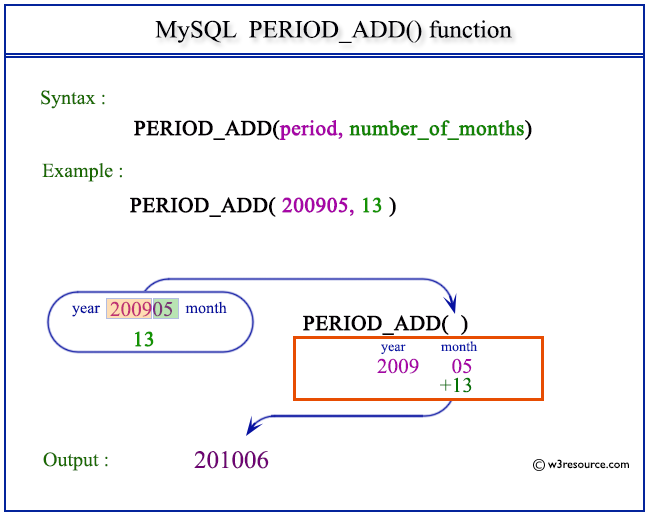MySQL PERIOD_ADD() function
PERIOD_ADD() function
MySQL PERIOD_ADD() adds a number of months with a period and returns the value in the format YYYYMM OR YYMM. Remember that the format YYYYMM and YYMM are not date values. It provides a way to perform period arithmetic, which is particularly useful when dealing with data that is represented in periods (year-month intervals).
This function is useful in -
- The function is used to project periods into the future or past based on specified increments.
- PERIOD_ADD() aids in financial analysis that involves projecting future periods for planning and forecasting.
- The function is valuable for analyzing trends and patterns over extended periods by projecting time intervals.
- PERIOD_ADD() is used to aggregate data over projected periods, helping to create time-based summaries.
- PERIOD_ADD() can be used in scenarios where period values need to be transformed for specific purposes.
- PERIOD_ADD() is valuable for calculating future or past periods by adding a specific number of months to an existing period.
Syntax:
PERIOD_ADD(P,N);
Arguments:
| Name | Description |
|---|---|
| P | Indicates a period. |
| N | Indicates a number of months. |
Syntax Diagram:

MySQL Version: 8.0
Pictorial Presentation:

Example: MySQL PERIOD_ADD() function
The following statement will return a value in YYYYMM or YYMM format after adding 13 months with the period 200905.
Code:
SELECT PERIOD_ADD(200905,13);
Output:
mysql> SELECT PERIOD_ADD(200905,13); +-----------------------+ | PERIOD_ADD(200905,13) | +-----------------------+ | 201006 | +-----------------------+ 1 row in set (0.00 sec)
Video Presentation:
All Date and Time Functions:
Click here to see the MySQL Date and time functions.
Previous: NOW()
Next: PERIOD_DIFF()
